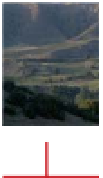Geology Reference
In-Depth Information
plate and an oceanic terrane repre-
sented now, in part, by the
Midland
Valley zone
, discussed below (Figure
12.4.4). The presence of a thick ophi-
olite sequence in eastern Shetland,
which includes a substantial upper
mantle component, has prompted
the suggestion that the Dalradian was
overlain by a large ophiolite nappe,
now removed by erosion, emplaced
prior to the collision. The presence
of extensive ophiolite sequences in
Newfoundland and Norway is evi-
dence that such a nappe may have
had a regional extent (Figure 12.5).
The F4 folds are confined to the
south-east part of the zone associated
with the Highland Boundary downbend
(Figure 12.3D, 12.4.6) and are attributed
to late Caledonian movements linked
with the collision with Avalonia (
see
below). A series of syn-orogenic plutons
ranging from granites to gabbros were
intruded in the period 470-460 Ma;
the granites are attributed to crustal
melting in the thickened orogen. The
many large post-orogenic granite
plutons, such as the famous Glencoe
and Ben Nevis complexes (discussed in
Chapter 8), are linked with a younger,
Silurian, episode of subduction (Figure
12.4.6) that will be discussed below.
Figure 12.3 opposite
Types of Caledonian structure.
A.
A typical foreland thrust-fold belt. Simplified
cross-section across part of the Moine Thrust zone showing four superimposed nappes: lower,
imbricate, Ben More and Moine nappes. The higher nappes were formed first and deformed as
the younger nappes developed beneath them. The imbricate nappe consists of numerous thin
slices of Cambrian strata, each sliding on a weak layer of shales that form the basal,
sole thrust
of the nappe. The slices propagate progressively forwards towards the foreland. Based on Elliott
& Johnson (1980).
B.
View of the Glencoul thrust from Kylesku, Sutherland, carrying Lewisian
basement over Cambrian quartzite, itself lying unconformably on Lewisian basement.
C.
Simplified
cross-section through the central part of the Grampian Highlands (the metamorphic core zone)
showing the effects of superimposition of F2 recumbent folds (axial surfaces shown by heavy black
dashed lines) on earlier isoclinal folds (thin black lines); both are refolded by upright F3 folds (black
dashed lines). The red lines are major thrust-sense shear zones. Based on Treagus (2000).
D.
The
Highland boundary downbend. The anticlinal fold hinge of the recumbent Tay nappe is steepened
immediately NW of the Highland Boundary Fault (HBF) to form an upright synform; only the
inverted lower limb of the fold is exposed; the arrows show the direction of younging of the strata.
E.
Illustrative sketch section across the north-western part of the Southern Uplands zone showing
how a series of packages of Ordovician strata, each becoming younger NW-wards, are bounded by
reverse faults now steepened into near vertical attitude. The folds are typically asymmetric with a
SE-up overthrust sense of movement.
F.
Sketch to show how the slaty cleavage planes in parts of
the Southern Uplands are aligned clockwise from the fold axis, indicating a component of sinistral
shear during compression.
G.
Simplified profile across the Welsh Basin of a notional folded surface
showing the variation in fold geometry from overfolds related to thrusts to gentle folds elsewhere.
The blue lines represent the attitude of the slaty cleavage in the more highly strained parts of
the section in North Wales and Anglesey. CHT, Carmel Head Thrust; SS, Snowdon Syncline; TT,
Tremadoc Thrust; BA, Berwyn Anticline. Based on Coward & Siddans (1979).
12
100
101
Precambrian age, around 650 Ma.
Towards the top of the sequence are
turbidite
deposits and mafic lavas,
culminating in a limestone containing
Lower Cambrian trilobites. The upper
part of the sequence is therefore the
deeper-water equivalent to the shelf
deposits of the foreland. The basement
in the west is composed of gneisses
belonging to the ~1,800 Ma
Rhinns
complex
, but in the north-east, the
Dalradian rocks lie on gneisses of the
Central Highland complex
, which are
correlated with the Moine Supergroup.
The Dalradian rocks are affected
by metamorphism varying from
greenschist facies
in the south-west
to amphibolite facies in the north-
east. The classic
Barrovian meta-
morphic zones
were established in
the south-western to central Dal-
radian, but in the north-east, these
are replaced by the
Buchan
type,
representing higher-temperature,
lower-pressure metamorphism.
Grampian deformation has resulted
in several distinct phases of folding
(Figure 12.3C), usually numbered from
F1 to F4. F1 consists of NW-directed
ductile thrusts and recumbent folds;
these are refolded by F2 overfolds that
are also NW-directed in the north-west
part of the zone, but in the south-east
are flat lying and appear to be overthrust
towards the south-east (Figures 12.3C,
D). The last main phase of folding, F3,
consists of more upright folds with
a NE-SW trend. The main
regional
metamorphism
, dated at ~475-460 Ma,
accompanied the F1 and F2 folding
but the F3 folds were formed during
retrogressive metamorphism and were
characterised by
crenulation cleavages
(
see
Chapter 7; Figures 7.1C and 7.2).
The Grampian event is attributed
to a collision between the Laurentia
Major sinistral faults
The Scandian event seems to have
had little or no effect in the Gram-
pian zone, but minor tectonic activity
was experienced in the region of the
Highland Boundary Fault
and
Great
Glen Fault
during the late Silurian
(435-420 Ma) collision of Laurentia and
Avalonia. The F4 structures, includ-
ing the downbend along the Highland
Boundary fault, mentioned above, have



Search WWH ::

Custom Search